You have seen various types of electronic components they may be divided into two active and passive. Here is the definition of passive electronic components and their classification.
Definition of Passive Components:
“The devices which cannot control the flow of electrons by any other electrical signal are called passive components.” Resistors, capacitors, inductors, etc are passive components, they are reactive components.
Passive components can be broadly divided into three types resistive, inductive, and capacitive. Also, there are many devices and transducers which are passive.
Also, read the classification of electronics components, and what are active electronic components?
Classification of Passive Electronic Components
Types of Resistors:
Resistors are passive and widely used in circuits, they pass a fixed value of current for a constant voltage.
” Resistance can be defined as the ratio of voltage across a conductor to the current flowing through it, where all the physical parameters like pressure, temperature, length, Mass, etc are constant.”
Resistors are of two fixed types and variable types.
1.) Fixed resistors:
a.) Two-terminal resistors: These are commonly available widely used two-terminal resistors. They are mostly carbon resistors.
b.) Power resistors: Power resistors are designed to withstand and dissipate large amounts of power. They are also known as shunt resistors they can all large current through them and has low resistance.
c.) DIP resistors: DIP stand for dual-inline-package. They come in an IC package, having one common connection.
Resistors as shown:
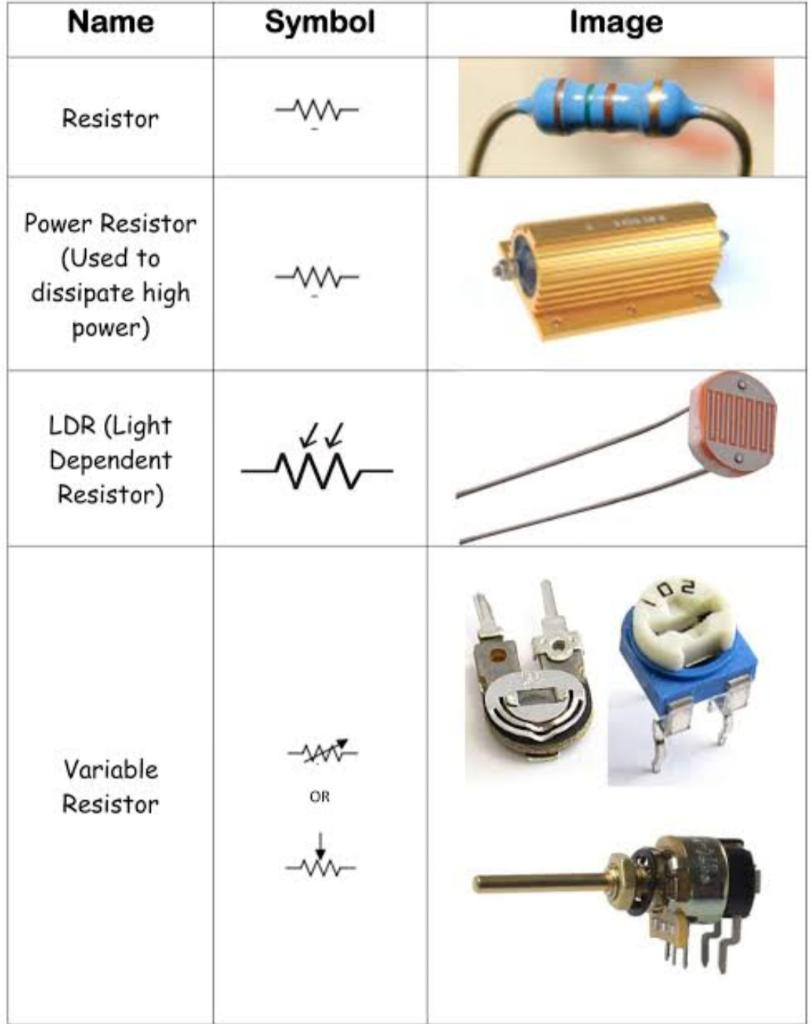
2.) Variable resistors:
Variable resistors are of different types depending on the factors they vary.
a.) Rheostat: It is a three-terminal variable resistor, out of three two are fixed terminals and one is a variable terminal.
b.) Potentiometer: It’s a three-terminal variable resistor that can be used as a voltage divider. It is small and has a knob.
c.) Trim pot: It is a small potentiometer usually for internal adjustments of circuits.
d.) Thermistor: It is a thermally sensitive resistor. Its resistance varies with temperature it is used for temperature measurements.
e.) Humistor: It’s a humidity-varied resistor, it’s resistance changes according to the humidity of the surroundings.
f.) Photoresistors: They are light-dependent resistors that produces a change in resistance and also provide voltage.
g.) Light-dependent resistors LDR: they are also light-dependent resistors but different from photoresistors.
h.) Varistor: They stand for Voltage-Dependent Resistor. Their resistance varies with the Voltage applied across them. They Pass current when an excessive voltage is present
i.) Resistance wire: Nichrome wire, manganin wire of high-resistance material are used as a heating element.
Types of Inductors (passive components):
“Inductors are passive electronic components that can store magnetic field across them when current passes through them.” They can be variable or fixed and are of three types.
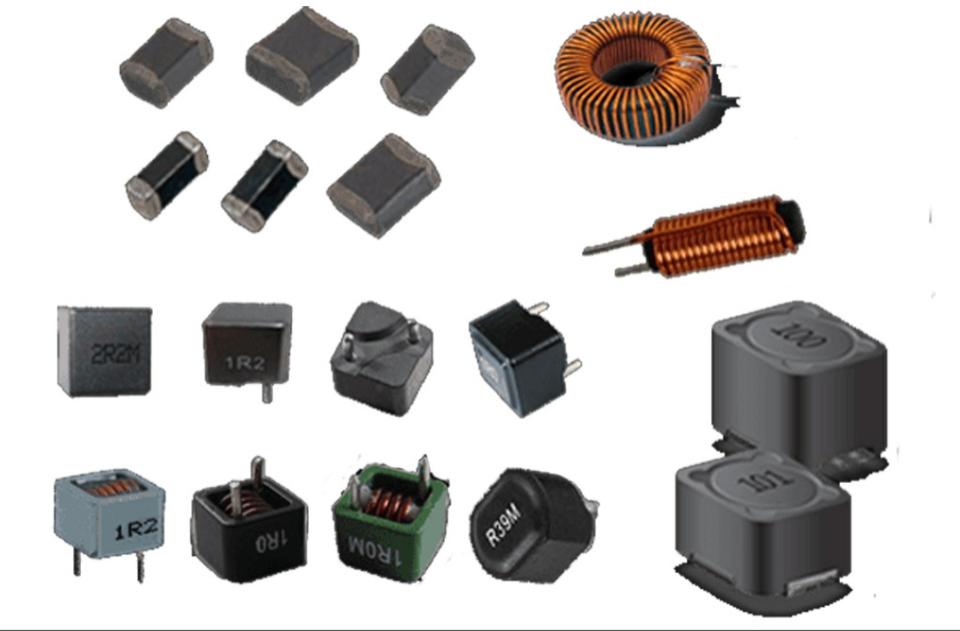
a.) Air core type: These are the wires wound around a hollow object having a number of turns.
b.) Iron core type: These inductors have an iron core.
c.) Ferrite core type: They have a ferrite core.
D.) Transformers: Transformers are passive devices that can increase or decrease Voltage or current. They have two inductors that are magnetically linked but electrically isolated from each other.
E.) Passive devices: there are many devices which we use daily come in this category.
Devices like motor, generator, solenoid, speakers, etc are passive devices.
Types of Capacitors:
“A capacitor is a passive device that can store electrical energy in terms of electric field.” It has two terminals when a potential is applied at one plate of the capacitor opposite potential is developed on the other plate. The electric field is stored in the medium between two plates.
Capacitors are basic building blocks of electronics, they store and release electrical charge. They are widely used for filtering power supplies, tuning resonant circuits, and blocking DC voltages meanwhile passing AC signals.
Capacitors can be broadly classified into two types fixed and variable.
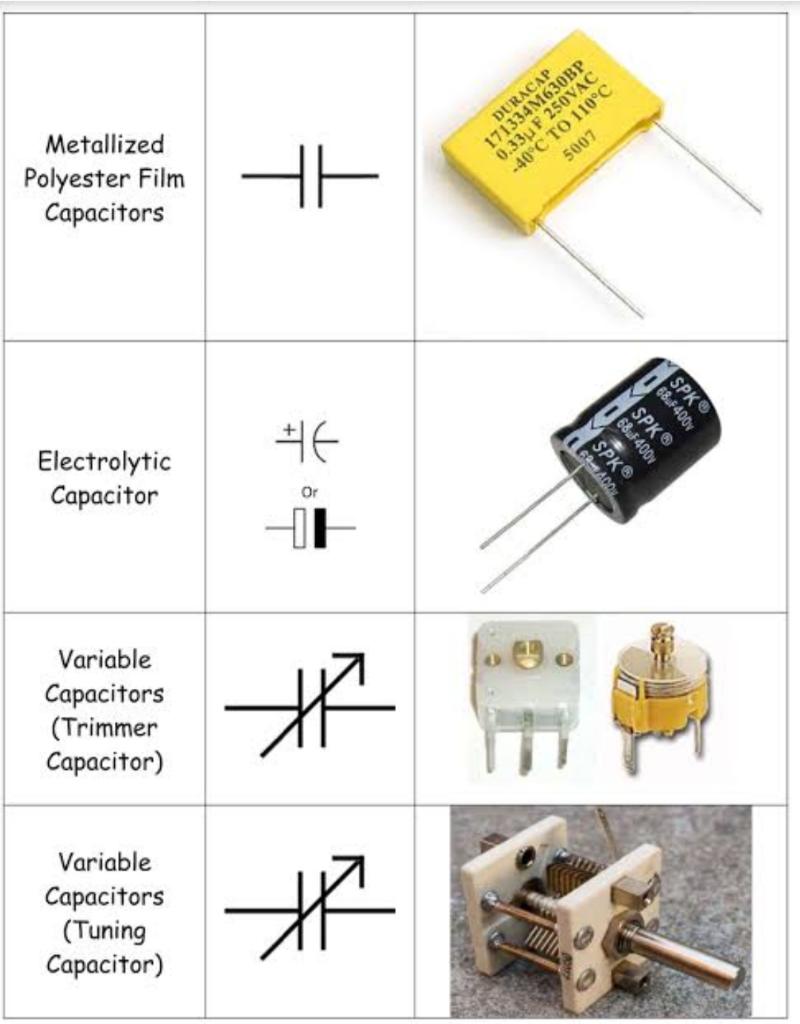
1.) Fixed capacitors:
These capacitors have a fixed value and a certain range of operating voltage. These passive electronic components are also of two types electrolytic and non-electrolytic.
Non – electrolytic:
These are mostly ceramic capacitors they have ceramic material in between the two plates. They are very cheap and easy to use.
a.) Ceramic capacitors
b.) Mica capacitors
c.) Film capacitors
Electrolytic: Electrolytic capacitors have an electrolytic medium between two plates. They are also known as polarized capacitors because they have polarities (+ and -).
Electrolytic capacitor these capacitors are divided on the basis of electrolyte they use.
a.) Aluminum electrolytic capacitor
b.) Tantalum electrolytic capacitor
c.) Niobium electrolytic capacitor
d.) Polymer capacitor
e.) Supercapacitor
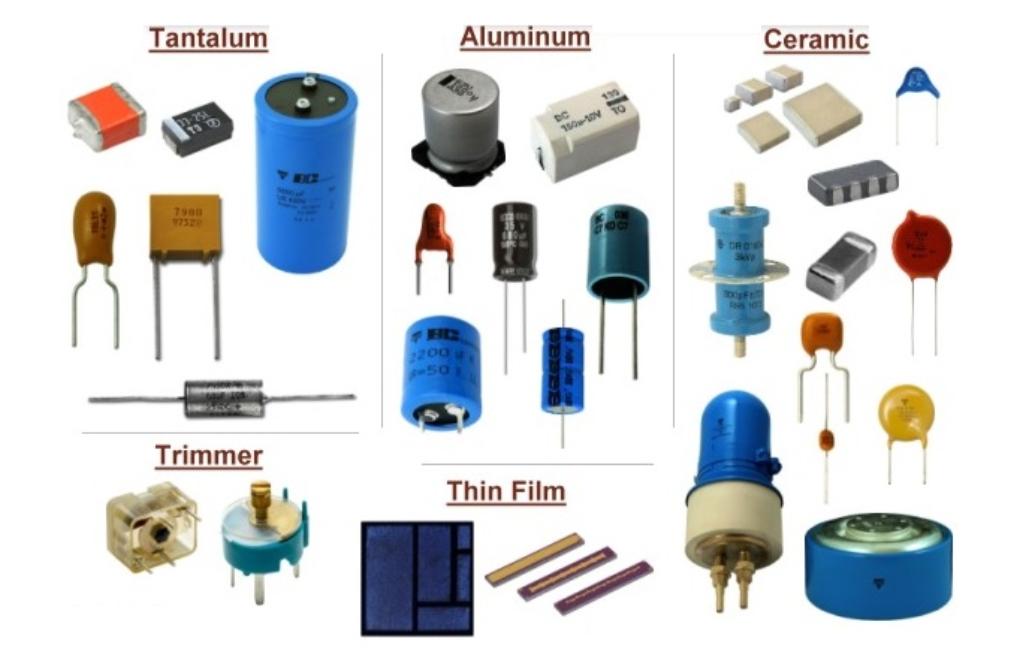
Integrated capacitors: capacitors also come in various sizes of IC packages having a large number of capacitors inbuilt.
2.) Variable capacitor:
They have variable capacitance and can be adjusted to a certain value.
a.) Tuning capacitor: They are used for tuning a radio, oscillator, or tuned circuit.
Trim capacitor: It’s a small variable capacitor used for rare adjustments of LC-circuits.
Capacitors for special applications There different capacitors designed for a special purpose application.
a.) Power capacitor
b.) Safety capacitor
c.) Light-emitting capacitor
d.) Motor capacitor
e.) Photoflash capacitor
f.) Reservoir capacitor
g.) Varicap: it’s a diode whose capacitance varies according to the voltage applied.
Passive devices transducer and sensors:
“Transducers generate an electrical signal when they are subjected to any physical change or vice versa.”
Sensors and transducers react to environmental conditions by changing their electrical properties or generating an electrical signal.
Commonly used Sensors and Transducer (Passive electronic components)
a.) Audio:
Loudspeaker: Electromagnetic or piezoelectric device to generate audio when it receives electrical signals.
Buzzer: Electromagnetic or piezoelectric sounder which generates tonnes
b.) Position, motion:
Linear variable differential transformer (LVDT): It is Electromagnetic and detects linear position.
Flowmeter: detects flow in liquid or gas.
Motion sensor: It can detect motion.
c.) Force and torque:
Strain gauge: It is a Piezoelectric or resistive transducer that can detect squeezing, stretching, and twisting action.
Accelerometer: It is used to detects acceleration and gravity, it is Piezoelectric.
d.) Thermal:
Thermocouple: It is Wires that generate a voltage proportional to change in temperature.
Thermistor: A kind of Resistor whose resistance changes with temperature PTC or NTC.
Resistance Temperature Detector (RTD): Wire whose resistance changes with temperature
Bolometer: used for measuring the power of incident electromagnetic radiation.
Thermal cutoff Switch: It gets opened or closed when a set temperature is exceeded.
e.) Magnetic field:
Magnetometer, Gaussmeter Hall effect sensor.
f.) Humidity sensor:
Hygrometer used to sense humidity.
g.) Antennas:
Antennas devices transmit or receive radio waves. Here are some types of antennas.
1.) Elemental dipole
2.) Yagi
3.) Phased array
4.) Loop antenna
5.) Parabolic dish
6.) Log-periodic dipole array
7.) Biconical
8.) Feedhorn
Components like Oscillator, Liquid crystal display (LCD), Digital voltmeters Filter Prototyping Breadboard passive.
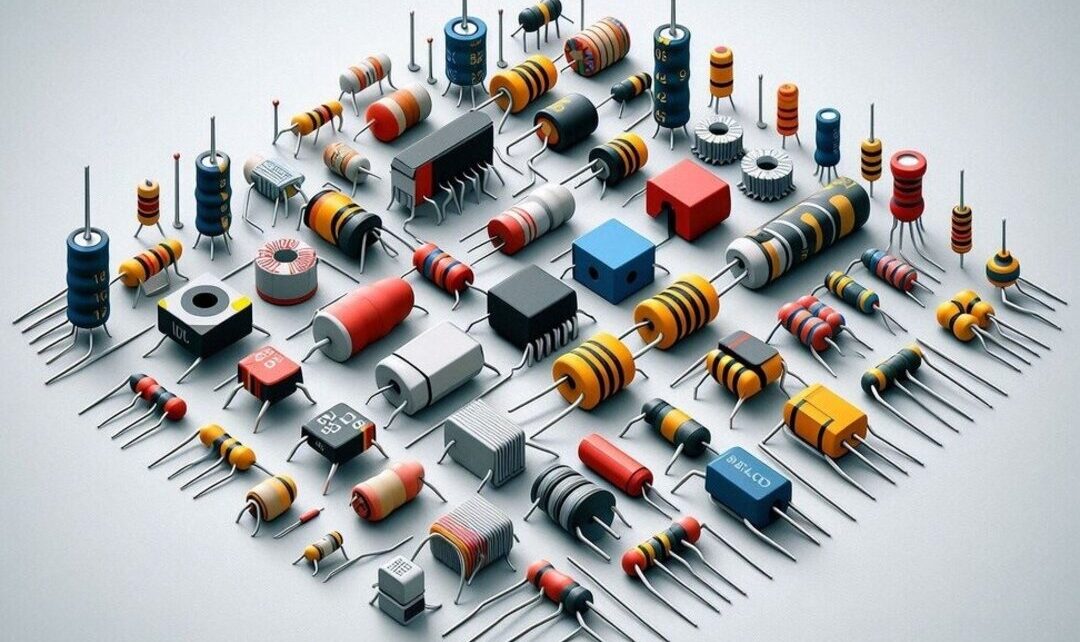
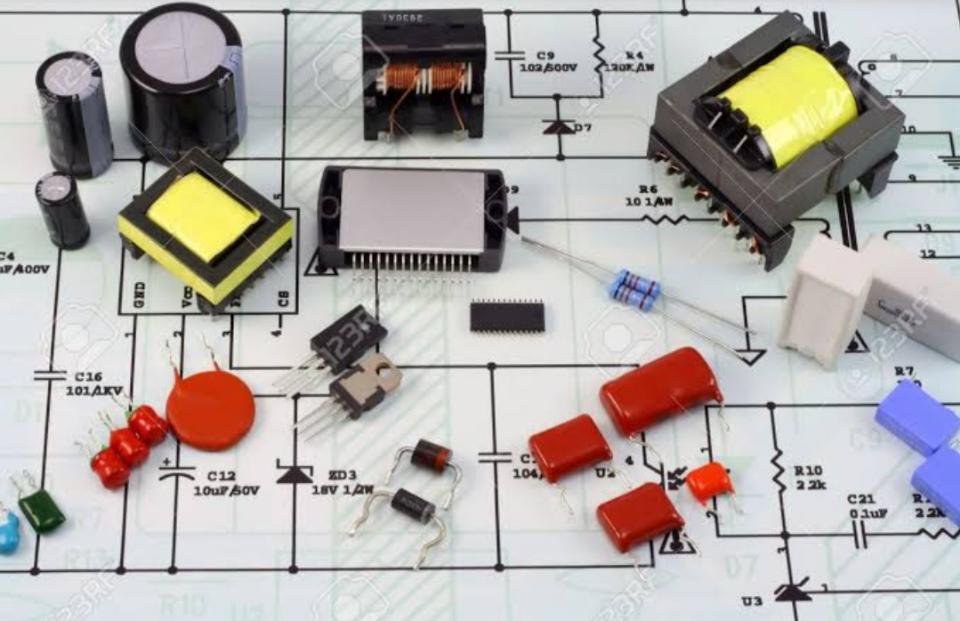

One Reply to “What are Passive Electronic Components and their Classification”